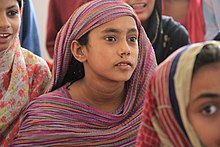
Sussi or susi (Soosey, Sousae) is a term for multicolored striped or checked cloth produced mainly in Sindh. Sussi is thin handloom fabric made of cotton, silk, or a blend of the two, with colored warp stripes. Sindh region was known for its production and exports during the Mughal period. Sussi was most often made with red and blue, blue and white, or green and white stripes, but other patterns were also produced. The fabric was exported to England, where sousaes were in great demand in the 18th century.
Name
Sussi was the umbrella term used for all striped fabrics.
Texture
Sussi is a plain fabric with warp vertical stripes. Sussi is produced with cotton, with silk, or with blended cotton and silk.
Dimensions
The fabric was 10 to 20 yards long and one yard in width.
Sussi Types and Production
Sussi along with other cotton varieties is produced at Hala, Nasarpur, Hyderabad, Thatta, Hoshiarpur, Gurdaspur, Lahore, Multan, Amritsar, Ludhiana, Jhang, Shahpur, Jalandhar, Delhi, Gurgaon, Rohtak, Karnal, Rewari, Panipat Salari was a type of handloom-produced sussi made at Kalabagh in Mianwali District, Pakistan.
Use
The cloth was used to make lowers such as pajamas and salwars (loose trousers). Blended sussi was used for pajamas and petticoats.
See also
References
- ^ Montgomery, Florence M. (1984). Textiles in America 1650-1870 : a dictionary based on original documents, prints and paintings, commercial records, American merchants' papers, shopkeepers' advertisements, and pattern books with original swatches of cloth. Internet Archive. New York; London : Norton. p. 349. ISBN 978-0-393-01703-8.
- Bunting, Ethel-Jane W. (1980). Sindhi Tombs and Textiles: The Persistence of Pattern. Maxwell Museum of Anthropology : University of New Mexico Press. ISBN 978-0-8263-0540-4.
- Bullo, Momin (2011). Matiari: The Cultural Capital of Sindh. District Government, Matiari.
- Tortora, Phyllis G.; Johnson, Ingrid (2013-09-17). The Fairchild Books Dictionary of Textiles. A&C Black. p. 600. ISBN 978-1-60901-535-0.
- Arts and Crafts of Pakistan. Export Promotion Bureau, Government of Pakistan. 1994. p. 48.
- Industries, Pakistan Ministry of; Yacopino, Feliccia (1977). Threadlines Pakistan. Ministry of Industries, Government of Pakistan. pp. 7, 58, 131.
- ^ "Woven Textiles – Asia InCH – Encyclopedia of Intangible Cultural Heritage". Retrieved 2020-12-07.
- Askari, Nasreen; Crill, Rosemary (1997). Colours of the Indus: Costume and Textiles of Pakistan. M. Holberton. ISBN 978-1-85894-045-8.
- ^ Baden-Powell, Baden Henry (1872). Hand-book of the Manufactures & Arts of the Punjab: With a Combined Glossary & Index of Vernacular Trades & Technical Terms ... Forming Vol. Ii to the "Hand-book of the Economic Products of the Punjab" Prepared Under the Orders of Government. Punjab printing Company. pp. 6, 37, 48, 58.
- "The living textile traditions of Sindh. - Free Online Library". www.thefreelibrary.com. Retrieved 2023-06-11.
- susi / Swedish hemp susi A group of plain weave fabrics made in India and Pakistan for use in women's trousers and for belts or sashes. ... In Pakistan, they are made with colored tussah silk stripes on cotton ground, bright-colored warp stripes of silk or cotton, and colored wool or silk stripes https://www.google.co.in/books/edition/The_Fairchild_Books_Dictionar Dictionary of Textiles - Page 600 Phyllis G. Tortora, Ingrid Johnson · 2013 Read page 600
- ^ Service, Tribune News. "Amritsar to Chennai: Journey of salwar kameez". Tribuneindia News Service. Retrieved 2020-12-06.
- Harris, Jennifer (2020-09-16). A Companion to Textile Culture. John Wiley & Sons. p. 179. ISBN 978-1-118-76890-7.
- ^ Parshad, Gopal (2007). Industrial Development in Northern India: A Study of Delhi, Punjab and Haryana, 1858-1918. National Book Organisation. p. 59. ISBN 978-81-87521-20-4.
- Parshad, Gopal (2007). Industrial Development in Northern India: A Study of Delhi, Punjab and Haryana, 1858-1918. National Book Organisation. p. 48. ISBN 978-81-87521-20-4.
- Saḥrāʼī, Tāju (1997). Lake Manchar: The Most Ancient Seat of Sindhu Cultures. Sindhi Kitab Ghar. p. 172. ISBN 978-969-8281-01-4.
- Tortora, Phyllis G.; Johnson, Ingrid (2013-09-17). The Fairchild Books Dictionary of Textiles. A&C Black. p. 525. ISBN 978-1-60901-535-0.
| State of Punjab, India | ||
|---|---|---|
| Capital: Chandigarh | ||
| Topics |  | |
| Administration | ||
| Culture |
| |
| Divisions |
| |
| Districts | ||
| Major cities | ||
| History |  | |
|---|---|---|
| Government | ||
| Culture | ||
| Geography | ||
| Divisions |
| |
| Districts |
| |
| Education | ||
| Sport | ||
| Major cities | ||